Multiscale Precipitating Characteristics of Categorized Extremely Persistent Flash Heavy Rainfalls over the Sichuan Basin in China Based on SOM and Multi-Source Datasets
Abstract
1. Introduction
2. Data and Method
2.1. Reanalysis Datasets, Observations, and Satellite Precipitation Products
2.2. Identification of EPHRs, EPHR Events, and Their Different Phases
2.3. SOM Classification
2.4. Diagnostic and Evaluation Metrics
3. Results
3.1. Circulation Classification of EPHRs and Associated Precipitating Characteristics from Multi-Source Datasets
3.2. Evaluations Among Datasets
4. Discussion
5. Conclusions
- Regarding the spatiotemporal distribution and evolution characteristics of all EPHR events, ERA5 and CMORPH accurately depict the basin-averaged peak 3 h precipitation around 0500 LST, consistent with rain gauge observations. In contrast, MSWX produces an earlier peak at 0200 LST. ERA5 overestimates afternoon precipitation, generating a secondary peak around 1700 LST. Both ERA5 and MSWX underestimate nocturnal precipitation intensity across the basin, while CMORPH achieves better consistency with station observations. The primary regions of heavy accumulated precipitation are located in the western basin according to CMORPH and MSWX, whereas ERA5 indicates a northwestern concentration. Only CMORPH capably captures precipitation over the central basin, though it still underestimates intensity. CMORPH outperforms the other datasets in describing precipitation development despite overestimating GT by approximately 1 h on average. For precipitation decay phases, MSWX most closely reproduces the FT distribution observed by rain gauges.
- Analysis of EPHR event characteristics across the three circulation types reveals that in SHN-type events, CMORPH depicts peak precipitation around 0500 LST, exhibiting a 3 h delay compared to observations, with accumulated precipitation primarily concentrated in the western basin. For WSH-type events, CMORPH produces superior spatial distribution and diurnal variation representations relative to the other datasets, though it underestimates precipitation magnitude. During LLJ-type events, CMORPH underestimates precipitation in the northwestern basin. While CMORPH effectively captures precipitation evolution in the WSH and LLJ types, it underestimates the GT for SHN-type precipitation. MSWX consistently exhibits the lowest mean precipitation intensity across all circulation types. ERA5 shows a distinct peak around 17 LST, exceeding its nocturnal peak intensity during LLJ-type events. Both ERA5 and MSWX overestimate precipitation GT in WSH- and LLJ-type events and FT in SHN-type events.
- CMORPH demonstrates significantly higher CORR than the other datasets at most stations. However, its TS in the western basin is approximately 0.1 lower than the other products at several stations. The basin-averaged POD and TS values for CMORPH remain below those of the other datasets across all precipitation thresholds, confirming systematic detection failures for certain precipitation events in the western basin. This under-detection occurs consistently across all circulation types and may stem from satellite retrieval limitations: precipitation mechanisms influenced by cloud shielding and orographic lifting in the western basin, coupled with reduced observational capability for nighttime cloud-top brightness temperatures in infrared satellite data. While MSWX and ERA5 exhibit comparable performance metrics across various precipitation thresholds and tend to generate more false alarms during low-intensity precipitation periods, regional differences exist. Specifically, MSWX achieves lower RMSE than ERA5 at some stations in the western basin, while ERA5 produces higher TS values in the south-central basin region.
Author Contributions
Funding
Data Availability Statement
Acknowledgments
Conflicts of Interest
References
- Li, Q.; Wu, F.; Yang, S.; Cui, X.; Zhang, Y.; Zhang, W. Statistics of warm-season hourly extreme precipitation in the Sichuan Basin, China during 2002–2021. Theor. Appl. Climatol. 2024, 155, 4465–4480. [Google Scholar] [CrossRef]
- Zhao, R.; Chen, B.; Zhang, W.; Yang, S.; Xu, X. Formation mechanisms of persistent extreme precipitation events over the eastern periphery of the Tibetan Plateau: Synoptic conditions, moisture transport and the effect of steep terrain. Atmos. Res. 2024, 304, 107341. [Google Scholar] [CrossRef]
- Xia, F.; Huang, X.; Fei, J.; Wang, J.; Cheng, X.; Zhang, C. Influence of Synoptic Pattern on the Spatiotemporal Features and Diurnal Variation of Extremely Persistent Heavy Rainfall over the Sichuan Basin, China. Adv. Atmos. Sci. 2025, 42, 527–550. [Google Scholar] [CrossRef]
- Xu, X.; Huang, A.; Zhang, Y.; Yang, X.; Zhao, W. Impact of Large-Scale Topography Surrounding the Sichuan Basin on Its Regional Precipitation. J. Geophys. Res. Atmos. 2025, 130, e2024JD042239. [Google Scholar] [CrossRef]
- Trenberth, K. Uncertainty in hurricanes and global warming. Science 2005, 308, 1753–1754. [Google Scholar] [CrossRef] [PubMed]
- Min, S.K.; Zhang, X.; Zwiers, F.W.; Hegerl, G.C. Human contribution to more-intense precipitation extremes. Nature 2011, 470, 378–381. [Google Scholar] [CrossRef]
- Donat, M.; Lowry, A.; Alexander, L.; O’Gorman, P.A.; Maher, N. More extreme precipitation in the world’s dry and wet regions. Nat. Clim. Change 2016, 6, 508–513. [Google Scholar] [CrossRef]
- Li, X.; Zhang, K.; Bao, H.; Zhang, H. Climatology and changes in hourly precipitation extremes over China during 1970–2018. Sci. Total Environ. 2022, 839, 156297. [Google Scholar] [CrossRef]
- Xiang, Y.; Li, Z.; Wu, Y.; Wang, K.; Yang, J. Spatiotemporal Characteristics of Hourly-Scale Extreme Precipitation in the Sichuan Basin and Its Impact on Normalized Difference Vegetation Index Values. Atmosphere 2023, 14, 1719. [Google Scholar] [CrossRef]
- Liu, Y.; Wang, Z.; Deng, C.; Zhai, D.; Han, Y.; Pang, Y.; Zhou, Y.; Luo, F. Climatic characteristics of hourly extreme precipitation during the warm season in Chongqing. Geomatics. Nat. Hazards Risk 2024, 15, 2278893. [Google Scholar] [CrossRef]
- Sheridan, P.; Xu, A.; Li, J.; Furtado, K. Use of targeted orographic smoothing in very high resolution simulations of a downslope windstorm and rotor in a sub-tropical highland location. Adv. Atmos. Sci. 2023, 40, 2043–2062. [Google Scholar] [CrossRef]
- Jiang, R.; Cui, X.; Lin, J.; Tian, J. 40-Year Statistics of Warm-Season Extreme Hourly Precipitation over Southwest China. J. Appl. Meteor. Climatol. 2023, 62, 1891–1908. [Google Scholar] [CrossRef]
- Zhang, C.; Huang, X.; Fei, J.; Luo, X.; Zhou, Y. Spatiotemporal characteristics and associated synoptic patterns of extremely persistent heavy rainfall in southern China. J. Geophys. Res. Atmos. 2021, 126, e2020JD033253. [Google Scholar] [CrossRef]
- Liu, H.; Huang, X.; Fei, J.; Zhang, C.; Cheng, X. Spatiotemporal features and associated synoptic patterns of extremely persistent heavy rainfall over China. J. Geophys. Res. Atmos. 2022, 127, e2022JD036604. [Google Scholar] [CrossRef]
- Wang, W.; Lin, H.; Chen, N.; Chen, Z. Evaluation of multi-source precipitation products over the Yangtze River Basin. Atmos. Res. 2021, 249, 105287. [Google Scholar] [CrossRef]
- Tang, X.; Li, H.; Qin, G.; Huang, Y.; Qi, Y. Evaluation of Satellite-Based Precipitation Products over Complex Topography in Mountainous Southwestern China. Remote Sens. 2023, 15, 473. [Google Scholar] [CrossRef]
- Wu, H.; Yong, B.; Shen, Z. Research on the Monitoring Ability of Fengyun-Based Quantitative Precipitation Estimates for Capturing Heavy Precipitation: A Case Study of the “7·20” Rainstorm in Henan Province, China. Remote Sens. 2023, 15, 2726. [Google Scholar] [CrossRef]
- Pang, Z.; Zhang, Y.; Shi, C.; Gu, J.; Yang, Q.; Pan, Y.; Wang, Z.; Xu, B. A Comprehensive Assessment of Multiple High-Resolution Precipitation Grid Products for Monitoring Heavy Rainfall during the “7.20” Extreme Rainstorm Event in China. Remote Sens. 2023, 15, 5255. [Google Scholar] [CrossRef]
- Zhang, W.; Di, Z.; Liu, J.; Zhang, S.; Liu, Z.; Wang, X.; Sun, H. Evaluation of Five Satellite-Based Precipitation Products for Extreme Rainfall Estimations over the Qinghai-Tibet Plateau. Remote Sens. 2023, 15, 5379. [Google Scholar] [CrossRef]
- Zhang, C.; Chen, X.; Shao, H.; Chen, S.; Liu, T.; Chen, C.; Ding, Q.; Du, H. Evaluation and Intercomparison of High-Resolution Satellite Precipitation Estimates—GPM, TRMM, and CMORPH in the Tianshan Mountain Area. Remote Sens. 2018, 10, 1543. [Google Scholar] [CrossRef]
- Sharma, S.; Chen, Y.; Zhou, X.; Yang, K.; Li, X.; Niu, X.; Hu, X.; Khadka, N. Evaluation of GPM-Era Satellite Precipitation Products on the Southern Slopes of the Central Himalayas Against Rain Gauge Data. Remote Sens. 2020, 12, 1836. [Google Scholar] [CrossRef]
- Du, J.; Yu, X.; Zhou, L.; Ren, Y.; Ao, T. Precipitation Characteristics across the Three River Headwaters Region of the Tibetan Plateau: A Comparison between Multiple Datasets. Remote Sens. 2023, 15, 2352. [Google Scholar] [CrossRef]
- Joyce, R.J.; Xie, P. Kalman filter–based CMORPH. J. Hydrometeorol. 2011, 12, 1547–1563. [Google Scholar] [CrossRef]
- Joyce, R.J.; Janowiak, J.E.; Arkin, P.A.; Xie, P. CMORPH: A method that produces global precipitation estimates from passive microwave and infrared data at high spatial and temporal resolution. J. Hydrometeorol. 2004, 5, 487–503. [Google Scholar] [CrossRef]
- Beck, H.E.; Van Dijk, A.I.; Larraondo, P.R.; McVicar, T.R.; Pan, M.; Dutra, E.; Miralles, D.G. MSWX: Global 3-Hourly 0.1° Bias-Corrected Meteorological Data Including Near-Real-Time Updates and Forecast Ensembles. Bull. Am. Meteorol. Soc. 2022, 103, E710–E732. [Google Scholar] [CrossRef]
- Beck, H.E.; Pan, M.; Roy, T.; Weedon, G.P.; Pappenberger, F.; van Dijk, A.I.J.M.; Huffman, G.J.; Adler, R.F.; Wood, E.F. Daily evaluation of 26 precipitation datasets using Stage-IV gauge-radar data for the CONUS. Hydrol. Earth Syst. Sci. 2019, 23, 207–224. [Google Scholar] [CrossRef]
- Cheng, L.; Shen, R.; Shi, C.; Bai, L.; Yang, Y. Evaluation and Verification of CMORPH and TRMM 3B42 Precipitation Estimation Products. Meteorol. Mon. 2014, 40, 1372–1379. (In Chinese) [Google Scholar] [CrossRef]
- Hafizi, H.; Sorman, A.A. Integrating Meteorological Forcing from Ground Observations and MSWX Dataset for Streamflow Prediction under Multiple Parameterization Scenarios. Water 2022, 14, 2721. [Google Scholar] [CrossRef]
- Mo, C.; Wan, X.; Lei, X.; Chen, X.; Ma, R.; Huang, Y.; Sun, G. Hydrometeorological Insights into the Forecasting Performance of Multi-Source Weather over a Typical Hill-Karst Basin, Southwest China. Atmosphere 2024, 15, 236. [Google Scholar] [CrossRef]
- Huang, X.; Zhang, C.; Fei, J.; Cheng, X.; Ding, J.; Liu, H. Uplift mechanism of coastal extremely persistent heavy rainfall (EPHR): The key role of low-level jets and ageostrophic winds in the boundary layer. Geophys. Res. Lett. 2022, 49, e2021GL096029. [Google Scholar] [CrossRef]
- Xia, F.; Huang, X.; Fei, J.; Wang, J.; Cheng, X.; Zhang, C. Mechanisms of Ageostrophic Wind Convergence in the Boundary Layer of Coastal Warm-Sector Extreme Heavy Rainfall in South China. J. Geophys. Res. Atmos. 2023, 128, e2022JD038472. [Google Scholar] [CrossRef]
- Kohonen, T. Self-Organizing Maps; Springer: Berlin/Heidelberg, Germany, 2001; pp. 245–261. [Google Scholar] [CrossRef]
- Stryhal, J.; Beranová, R.; Huth, R. Representation of Modes of Atmospheric Circulation Variability by Self-Organizing Maps: A Study Using Synthetic Data. J. Geophys. Res. Atmos. 2023, 128, e2023JD039183. [Google Scholar] [CrossRef]
- Barnes, S.L. A technique for maximizing details in numerical weather map analysis. J. Appl. Meteor. 1964, 3, 396–409. [Google Scholar] [CrossRef]
- Koch, S.E.; DesJardins, M.; Kocin, P.J. An interactive Barnes objective map analysis scheme for use with satellite and conventional data. J. Appl. Meteor. Climatol. 1983, 22, 1487–1503. [Google Scholar] [CrossRef]
- Xu, X.; Xue, M.; Wang, Y.; Huang, H. Mechanisms of secondary convection within a Mei-Yu frontal mesoscale convective system in eastern China. J. Geophys. Res. Atmos. 2017, 122, 47–64. [Google Scholar] [CrossRef]
- Xue, M.; Luo, X.; Zhu, K.; Sun, Z.; Fei, J. The controlling role of boundary layer inertial oscillations in Meiyu frontal precipitation and its diurnal cycles over China. J. Geophys. Res. Atmos. 2018, 123, 5090–5115. [Google Scholar] [CrossRef]
- Hua, S.; Xu, X.; Chen, B. Influence of multiscale orography on the initiation and maintenance of a precipitating convective system in North China: A case study. J. Geophys. Res. Atmos. 2020, 125, e2019JD031731. [Google Scholar] [CrossRef]
- Zeng, W.; Chen, G.; Du, Y.; Wen, Z. Diurnal variations of low-level winds and precipitation response to large-scale circulations during a heavy rainfall event. Mon. Weather Rev. 2019, 147, 3981–4004. [Google Scholar] [CrossRef]
- Zhang, Y.; Xue, M.; Zhu, K.; Zhou, B. What is the main cause of diurnal variation and nocturnal peak of summer precipitation in Sichuan Basin, China? The key role of boundary layer low-level jet inertial oscillations. J. Geophys. Res. Atmos. 2019, 124, 2643–2664. [Google Scholar] [CrossRef]
- Xia, R.; Luo, Y.; Zhang, D.L.; Li, M.; Bao, X.; Sun, J. On the diurnal cycle of heavy rainfall over the Sichuan Basin during 10–18 August 2020. Adv. Atmos. Sci. 2021, 38, 2183–2200. [Google Scholar] [CrossRef]
- Chen, X.; Cao, D.; Liu, Y.; Xu, X.; Ma, Y. An observational view of rainfall characteristics and evaluation of ERA5 diurnal cycle in the Yarlung Tsangbo Grand Canyon, China. Q. J. R. Meteorol. Soc. 2023, 149, 1459–1472. [Google Scholar] [CrossRef]
- Su, J.; Wang, X.; Ren, W.; Liu, W. Decomposing precipitation biases into frequency and intensity components: Comparative analysis of IMERG and ERA5-Land over the Tibetan Plateau. Atmos. Res. 2025, 326, 108320. [Google Scholar] [CrossRef]
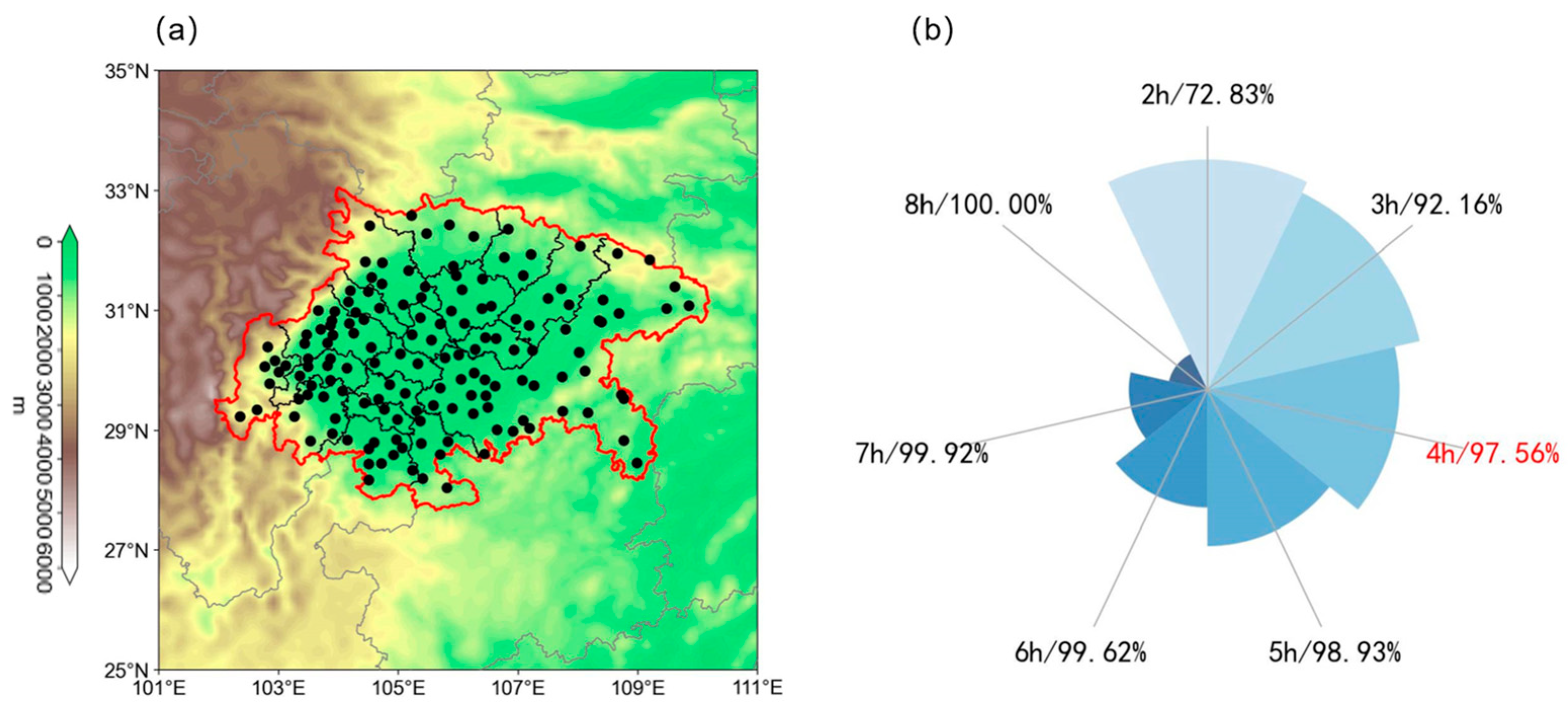
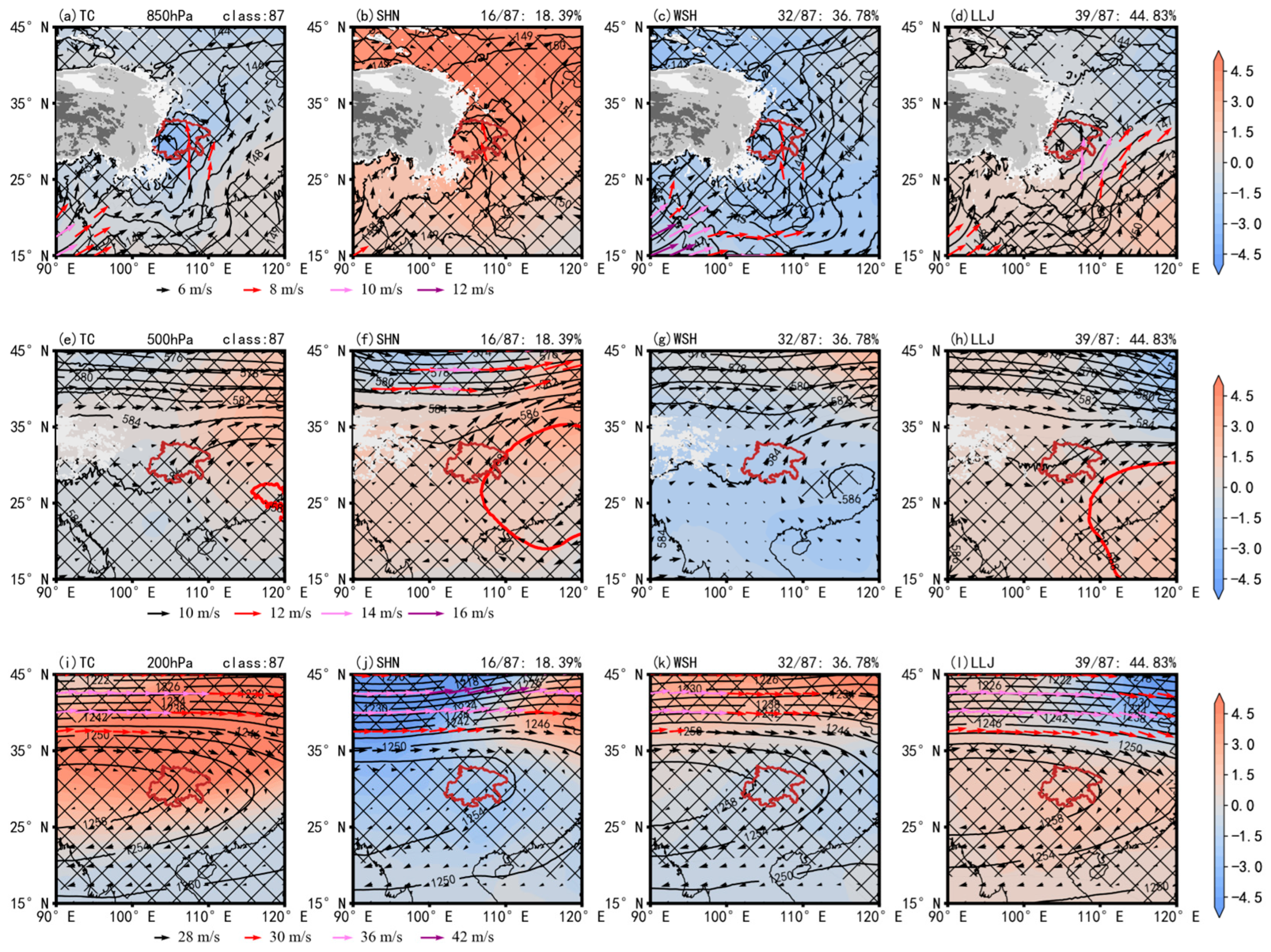

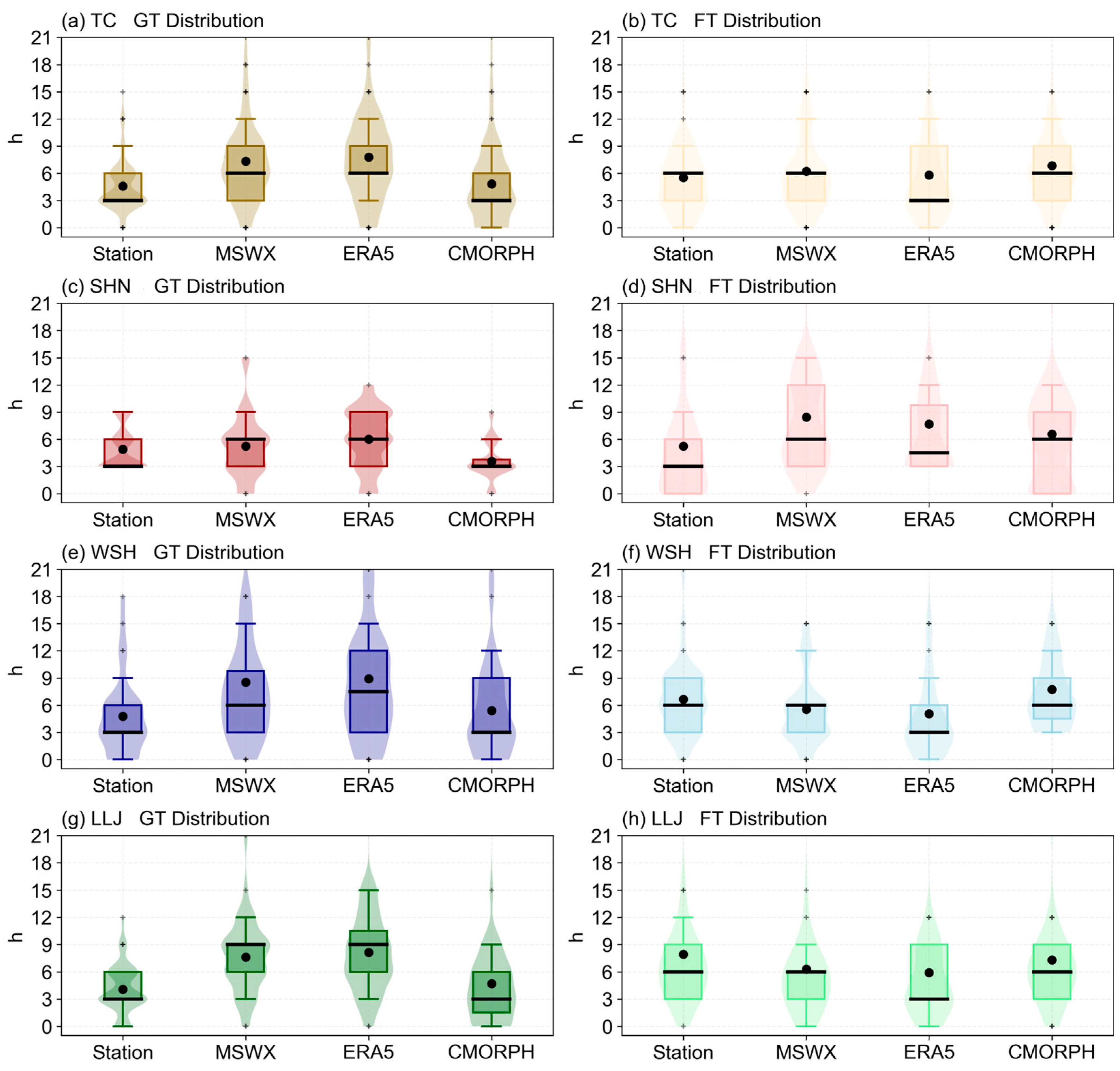
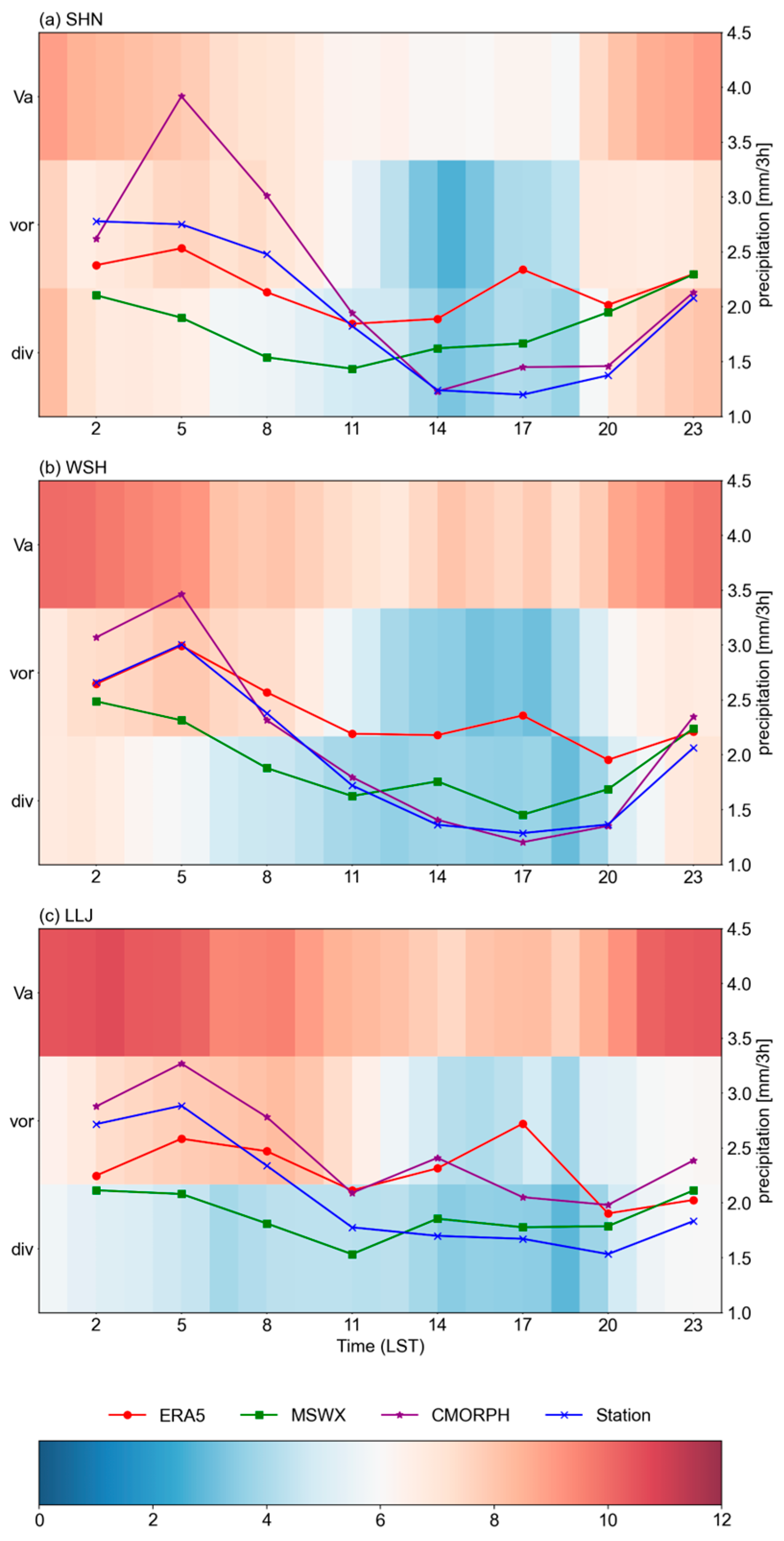

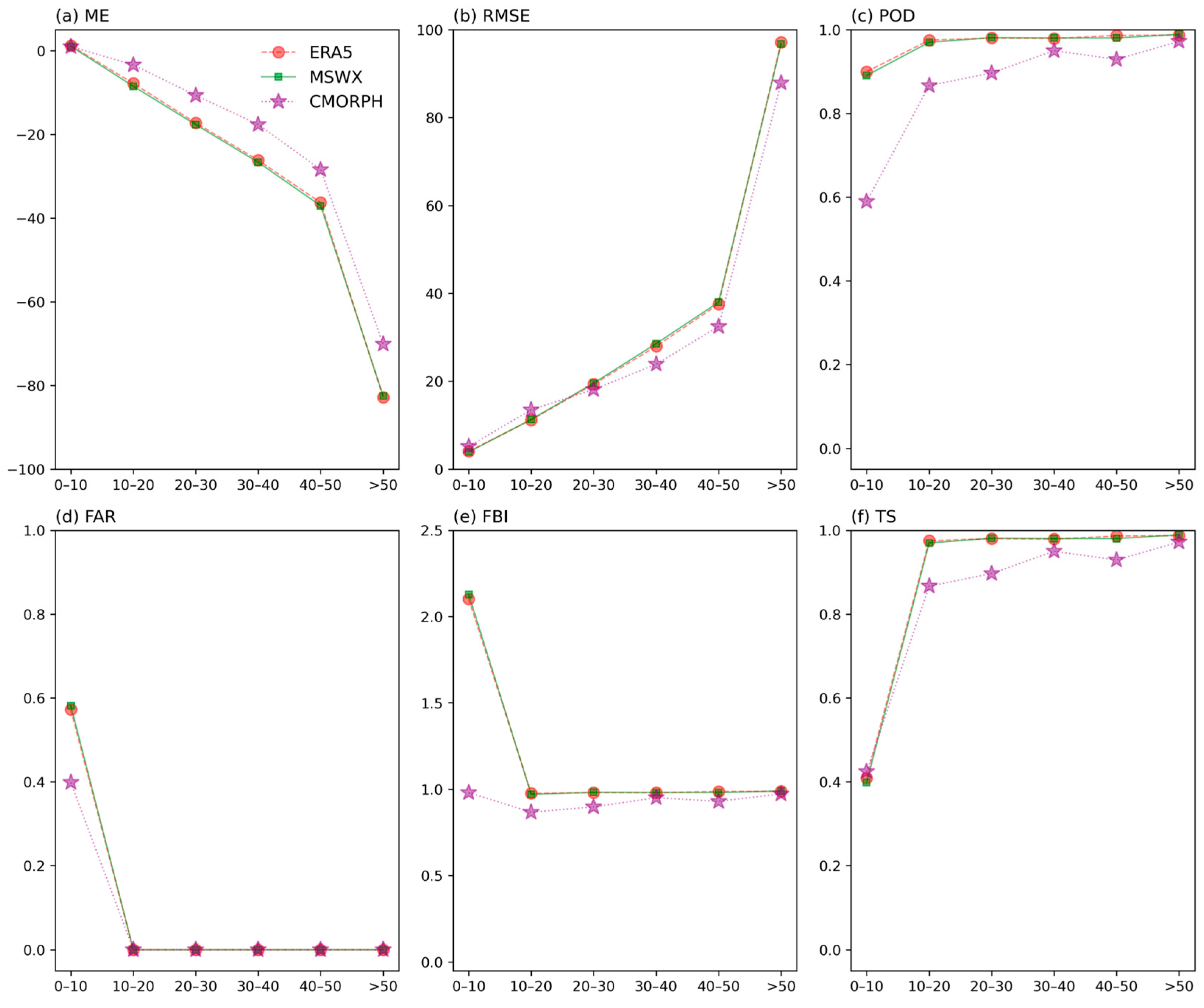
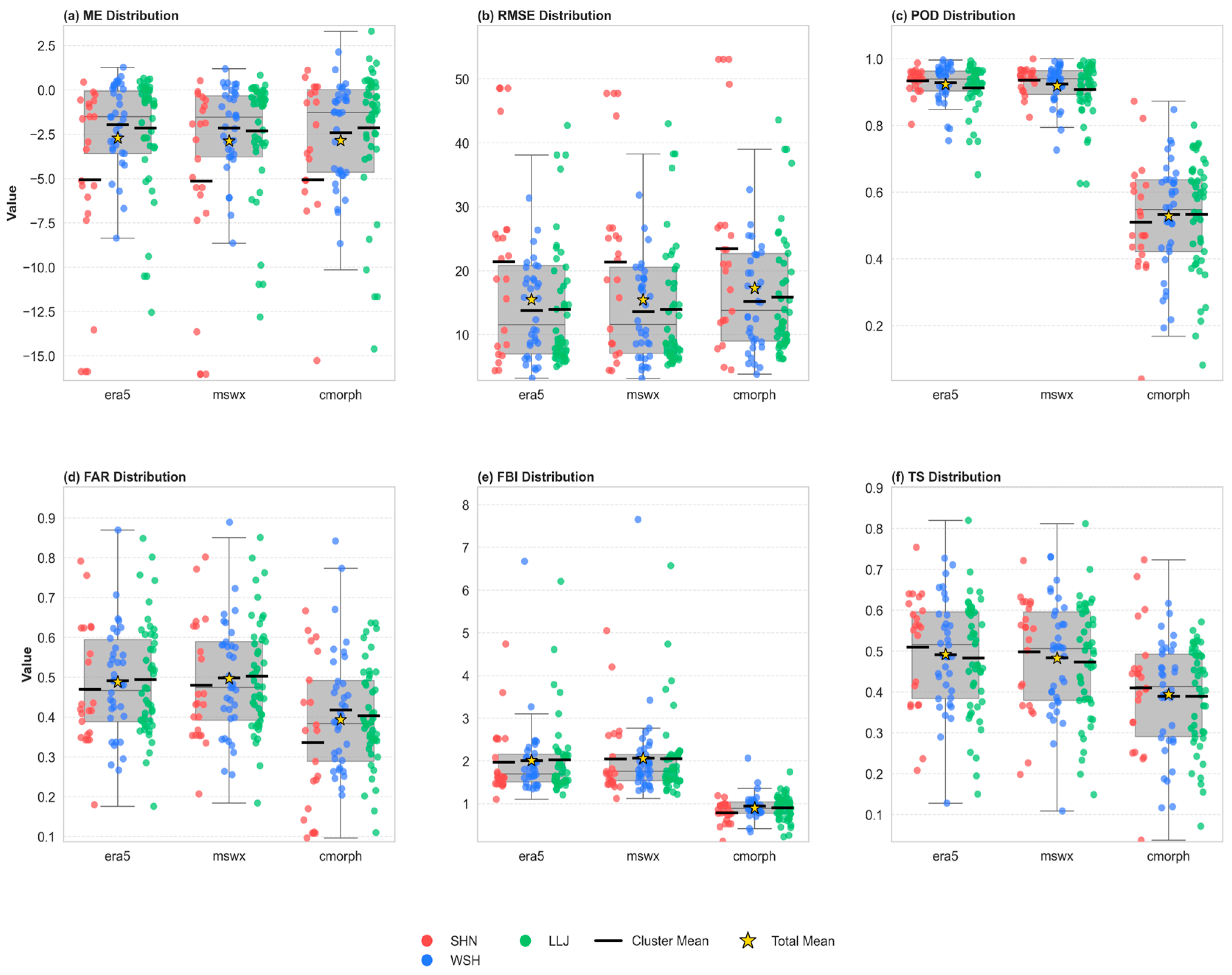
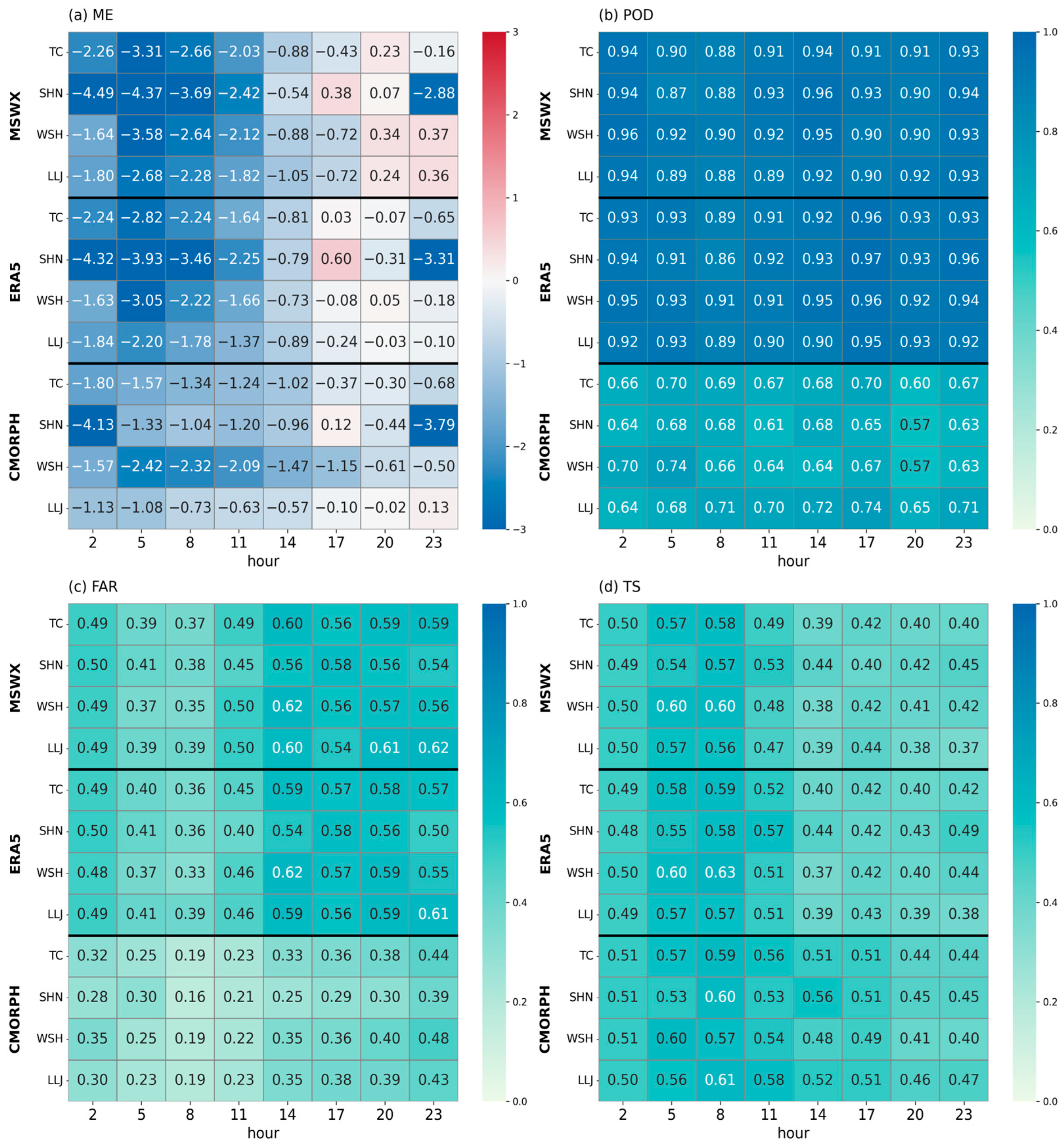
| Dataset Name | Spatiotemporal Resolution | Data Sources | Time Span |
|---|---|---|---|
| Rain gauge | -, 1 h | NMIC | 2003 to present |
| CMORPH | 8 km × 8 km, 0.5 h | NOAA | 1998 to present |
| MSWX-Past | 0.1° × 0.1°, 3 h | GloH2O | 1979 to present |
| ERA5 | 0.25° × 0.25°, 1 h | ECMWF | 1940 to present |
Disclaimer/Publisher’s Note: The statements, opinions and data contained in all publications are solely those of the individual author(s) and contributor(s) and not of MDPI and/or the editor(s). MDPI and/or the editor(s) disclaim responsibility for any injury to people or property resulting from any ideas, methods, instructions or products referred to in the content. |
© 2025 by the authors. Licensee MDPI, Basel, Switzerland. This article is an open access article distributed under the terms and conditions of the Creative Commons Attribution (CC BY) license (https://creativecommons.org/licenses/by/4.0/).
Share and Cite
Liu, C.; Cao, J.; Deng, C.; Qian, F. Multiscale Precipitating Characteristics of Categorized Extremely Persistent Flash Heavy Rainfalls over the Sichuan Basin in China Based on SOM and Multi-Source Datasets. Remote Sens. 2025, 17, 2761. https://doi.org/10.3390/rs17162761
Liu C, Cao J, Deng C, Qian F. Multiscale Precipitating Characteristics of Categorized Extremely Persistent Flash Heavy Rainfalls over the Sichuan Basin in China Based on SOM and Multi-Source Datasets. Remote Sensing. 2025; 17(16):2761. https://doi.org/10.3390/rs17162761
Chicago/Turabian StyleLiu, Changqing, Jie Cao, Chengzhi Deng, and Furong Qian. 2025. "Multiscale Precipitating Characteristics of Categorized Extremely Persistent Flash Heavy Rainfalls over the Sichuan Basin in China Based on SOM and Multi-Source Datasets" Remote Sensing 17, no. 16: 2761. https://doi.org/10.3390/rs17162761
APA StyleLiu, C., Cao, J., Deng, C., & Qian, F. (2025). Multiscale Precipitating Characteristics of Categorized Extremely Persistent Flash Heavy Rainfalls over the Sichuan Basin in China Based on SOM and Multi-Source Datasets. Remote Sensing, 17(16), 2761. https://doi.org/10.3390/rs17162761






